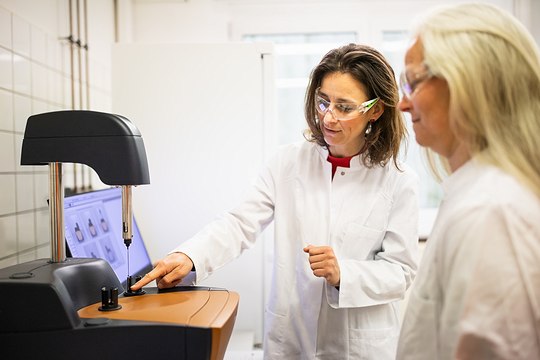Research
The objective of the Buchweitz group is to understand the impact of the food matrix on the release of phytochemicals during consumption and digestion, as well as to assess alterations in the digestibility of polysaccharides and proteins. To accomplish this, the group utilizes a comprehensive range of techniques to analyze the interaction between phytochemicals and macromolecular food matrices and their effects in the physiological context. Thus, the interactions of phytochemicals with digestive enzymes and processing- and consumption-related modifications on the digestibility of proteins and polysaccharides are comprehensively assessed under in vitro digestion conditions. This enables to evaluate the effect of phytochemicals and processing parameters on the glycaemic index, protein value and the allergenic potential of food and dietary supplements.
Impressions of our working group












Interactions of polyphenols with enzymes
How do polyphenols affect digestive enzymes?
Investigation of interactions using innovative methods
Background:
According to the International Diabetes Federation, around 537 million people worldwide in 2021 suffered from diabetes mellitus. It is estimated that the number will rise to 783 million by 2045. Approximately 90% of cases are type 2 diabetes mellitus, which is attributed to unhealthy dietary habits and lack of physical activity. A sustainably elevated level of blood sugar can lead to increased insulin secretion, resulting in insulin resistance in target cells (e.g., muscle cells) and irreversible damage to β-cells in the pancreas. Thus, blood sugar levels can no longer be balanced and impaired glucose tolerance and even hyperglycemia might result.
These abnormalities could cause damage to the kidneys, blood vessels and nerves. Pharmaceuticals such as metformin can cause unwanted side effects such as diarrhea, flatulence and stomach distension. Long-term use of these drugs may cause liver and kidney damage. Therefore, it is essential to explore the potential of natural bioactive compounds such as polyphenols, which are believed to offer similar benefits with fewer or negligible adverse side effects, as agents for managing type 2 diabetes mellitus.
Research objective:
The aim of the project is to investigate the interaction between polyphenols and digestive enzymes. This involves the determination of interaction strengths and mechanisms, as well as the impact on enzyme activity. Various approaches are applied to identify the specific phenolic structures responsible for the most significant reduction in digestive enzymes activity and starch digestibility. This research provides comprehensive insights into the effects of polyphenols in preventing type 2 diabetes mellitus, while also gives new insights into recommended foods or suitable sources of nutrients for dietary supplements.
Methods:
- In vitro digestion systems
- Isothermal titration calorimetry
Figure 1: Principle of Isothermal titration calorimetry und thermodynamic insights using isothermal titration calorimetry: Investigation of driving forces, interaction strengths, and stoichiometry in interaction studies. Figure 2: Exploring enzyme kinetics with isothermal titration calorimetry: Determination of Inhibition constants, advantages and applications - Surface plasmon resonance
Figure 3: Principle and advantages of surface plasmon resonance for real-time characterization of analyte-enzyme interactions - Saturation-transfer-difference NMR

Research topics for theses:
Isothermal titration calorimetry
- Further development of methodological approaches for determining enzyme kinetics using ITC, illustrated by the example of α-amylase
- Identification of potential inhibitors in complex plant extracts
- Investigation of the correlation between interaction and enzyme inhibition
- Examination of the interaction between starch and phenolic structures and their impact on starch digestibility
Surface plasmon resonance
Currently no topics available
Contact:
Mengyao Xiong
RG Buchweitz – Polyphenol-Matrix Interactions
Institute of Food Chemistry
Department of Chemistry
University of Hamburg
E-Mail: mengyao.xiong@uni-hamburg.de
Büro HS 05 – Martin-Luther-King-Platz 6
Impact factors on the allergenic potential of apples
Background:
Apples are particularly rich in valuable compounds and are considered to have various health benefits. However, approximately 2.5 million people in Germany suffer from an apple allergy, which is triggered by the allergen Mal d 1. This allergen has a similar three-dimensional structure to the main allergen of birch pollen (Bet v 1) (figure 1). Due to this similarity between the allergens, patients with birch pollinosis often suffer from an allergic cross-reaction as the immune system is unable to differentiate between them.

The symptoms of Mal d 1 mediated apple allergy are usually mild and confined to the mouth and throat. Clinical studies and consumer surveys have shown differences in the allergenic potential of various apple varieties. Especially, polyphenol-rich, traditional apple varieties from orchard meadows are reported as well tolerated.
Objective of the Research:
The objective is to identify possible factors that influence the allergenic potential of an apple variety. The study focuses on the following three hypotheses as cause for the observed variety specific allergenicity:
- Differences in the allergen content
- Differences in the Mal d 1 isoallergen profile and variances in the allergenicity of the isoallergens
- Interactions of polyphenols and Mal d 1 resulting in a possible shielding of IgE epitopes
To evaluate the first two hypotheses, the allergen content and isoallergen profile of different apple varieties are determined and the effect of the cropping system and storage are analyzed. To understand the relevance of polyphenol-Mal d 1 interactions on the allergenic potential, various analytical approaches are applied. Figure 2 provides a detailed visualization of the possible impact factors on allergenicity.

Analytical Methods:
- Determination of the isoallergenprofile via untargeted bottom up proteomics
- Isoallergenspecific Mal d 1 Quantification by targeted HPLC-MS (isotope dilution analysis)
- Determination of allergenic Mal d 1 by ELISA
- Characterization and quantification of polyphenols by HPLC-DAD and HPLC-MS
- Polyphenols-Mal d 1 interactions are studied by Isothermal Titration calorimetry, untargeted HPLC-MS and Saturation-Transfer-Difference Spectroscopy-NMR and 1H15N-HSQC-NMR
Topics for possible Final Theses:
- Matrix release of polyphenols and Mal d 1 during the consumption of fresh apples (oral ex vivo digestion model)
- Impact of different cropping and storage conditions on the isoallergen profile of Mal d 1
- Interaction studies of apple specific polyphenols with recombinant Mal d 1 by ITC und 1H15N-HSQC-NMR
- Development and implementation of an extraction method for polyphenol oxidase from apples for studying the browning kinetics of different polyphenolic structs and the impact of matrix compounds by ITC und HPLC-MS
Poster: Information for students 2023 (PDF)
Contact Details:
Julia Kaeswurm
AG Buchweitz – Polyphenol-Matrix Interaktions
Institute for Food Chemistrye
Department of Chemistry
University of Hamburg
E-Mail: julia.kaeswurm@uni-hamburg.de
Büro HS 005 – Martin-Luther-King-Platz 6
Overview articles (German):
Buchweitz, Maria; Kaeswurm, Julia; Straub, Leonie V.; Brockmeyer, Jens (2022): Die nächste Ebene der Allergenquantifizierung. Quantifizierungsmethode zur isoallergenspezifischen Quantifizierung des Apfelallergens Mal d 1. In: Margareta Dellert-Ritter (Hg.): Chrom+Food Forum. moderne Methoden, aktuelle Trends. Chrom+Food Forum. Aschaffenburg: MDR, S. 20–22. (PDF article - german)
Kaeswurm, Julia A.H.; Buchweitz, Maria# (2023): Ursachenforschung – Warum sind Apfelsorten unterschiedlich allergen? In: Lebensmittelchemie 77 (4), S. 98–103. DOI: 10.1002/lemi.202300401. (PDF article - german)
